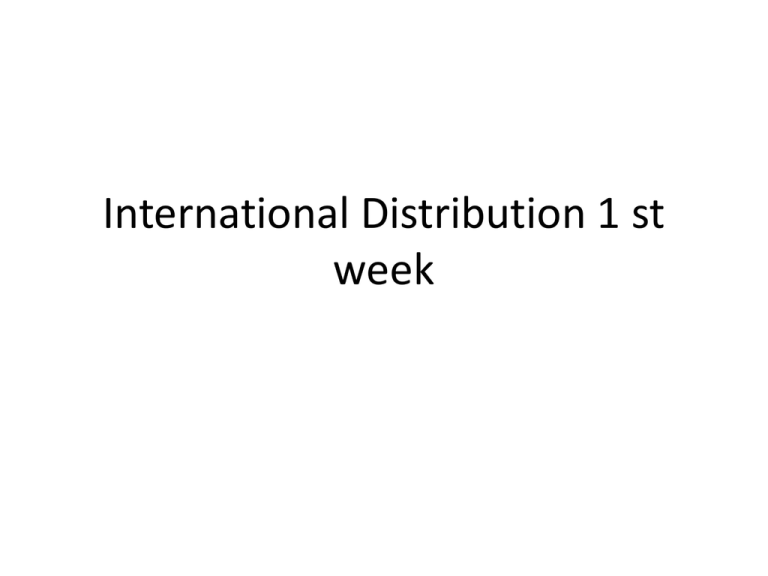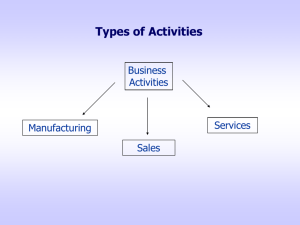International Distribution 1 st week
advertisement

International Distribution 1 st week Building an International network Survey conducted by Mckenzie on the 141 of the world’s leading CPG manufacturer’s The outperformers are best in class in customer and channel managment. • Customer managment • Sales strategy • Pricing • Trade promotion Five customer-managment imperatives • Identify pockets of growth and align resources against them • Overinvest in collaborative relationship with more important customers • Use deep insights and analytics to realise greater returns from pricing and promotion activities Five global customer-managment imperatives (cont) • Translate distinctive consumer insights into-in store advantages. • Increase sales using optimised route-tomarket models Company added value creation Suppliers processes Production process • Quality control • Logistic in • Quality control “market”process • Marketing • Sales and after sales • Logistic Why to build an international distribution network Why to build an international distribution network • Is part of the process of internationalisation of a company. • Is a dynamic process ,with a continuous evolution. • To compete at International level will oblige the company to make the right investments in order to improve the productivity and to accelerate the time to market of new products. Why to build an International distribution network • to take new opportunities and to reduce the risks ( increase of the numbers of the markets) • to exploit the full potential of the brands/products decreasing the costs ( more economies of scale ) and increasing the efficiency and the rentability. Different kind of Internationalisation strategies export globalisation delocalisation Different kinds of internationalisation strategies • Based on the export • Based on the decentralisation • Based on a global model Fundamentals for the success • Configuration of the localisation of the activities • Managment of the activities ( level of control and standardisation) EXECUTION, EXECUTION IMPLEMENTATION In which markets to enter ? In which country to focus the analysis Analysis of the main indicators Analysis of the demand The competition Internal analysis of the company objectives External elements Internal elements How to enter External elements • • • • • • Political situation Import duties Dimension of the market Competion structure Infrastructure Competencies level Internal elements • Products • Human resources • Financial resources Two areas • Business to consumer • Business to Business Business to consumer Which consumer Which area Which outlet Which consumer? • Consumer segmentation? CONSUMER SEGMENTATION • To segment means dividing the markets in many parts ( segments) ,in each of which are put consumers who have some characteristics in common and increasing in this way the effectiveness of the marketing mix by underlining ,to the interested segments, the characteristic of a product in which they are interested (USP ) Consumer segmentation • Segmentation by income • Segmentation by product characteristics ; price ,usage ( personal , family , gifting…) • Geographic Area • Life style • psycografic……. Were our consumer is located? • Urban area • Rural area Where your consumer is buying? • Traditional shops ( papa’s&mama’s shops) • Modern and organised trade ( CVS , supermarkets , hypers … • Department stores and Malls • E-commerce • ……. POINT OF SALES • The point of Sales is Key for the consumers good .Is the main point of engagement with the consumer. • For a strong Brand in the mind of the consumer ,the problems are starting when the consumer is entering in to the “arena.” ( the point of sales). • What is missing? Category of shops Modern trade Traditional trade Hypermarkets Papa&mama’ s Super markets Open markets discounters kiosks Mini markets CVS Categories of shops in fashion • ? Categories of shop in fashion • Multi brand stores • One brand store ( owned by the company or franchised ) • Department stores • Super or hyper • ? Potential of the point of sales • Is not always easy to define the potential of the different point of sales. • Some parameters can help; dimensions of point of sales, type of area in term of income , presence of offices , range of the products… • High medium and low potential (hyper , SM,MM, CVS ,…) Importance of the categorisation of the shops by potential ? Investments by potential category • Services ; number of deliveries per week, number of visit per month… • Support; merchandisers, promotions • Incentives; listing fees, end year bonuses.. • How to displays the products; in shelf, out shelves, dimensions of the displays • Remuneration; margin CHOICE OF THE SHOPS Define the target consumer Where rural area or city Modern trade or traditional and which category Route to market ;the process Which shops Which cost Consumer Which services How many Categorization of the point of Sales • Range per period ( high seasonality, low seasonality , festivities …) How to increase profitability More customers traffic Target undeveloped segments Shop more frequently Trips More occasions Basket size Address barriers to customers Spend more How to increase profitability Build customer loyalty Premium cards Special programs Differentiate with unique new products Special displays Temporary exclusivity Trade up to higher margin items More point of engagement Increase sell-out Coverage • Numerical distribution ; The number of shops selling a product category compared to the total number of shops selling the same category of products • Weighted distribution; the total value of a product category sold by a certain number of shops compared to the total value of the product category sold in the shops • Visibility degree of visibility of a brand or a preduct POINT OF SALES • In emerging markets in which the urban population is higher in term of % the distribution is more concentrated and the modern trade more present. • In the rural countries ( e.g. India )the distribution is more fragmented and the largest part of the shops is represented by papa’s and mama’s one’s • In many emerging markets the CVS are very present and can represent a large part of the distribution (Taiwan 40% in some business as confectionery ) POINT OF SALES • In the emerging markets the Hyper markets are in many cases an attraction . • The consumer, especially the youngs, are going there to see the new products • Displays and promotion in the point of sales are more important than in the advanced countries • The role of merchandisers is very important POINT OF SALES • In china 45 % of consumers make purchasing decisions inside shops (24% in US ). DISTRIBUTION IN CHINA • Modern trade is important in China ;62% • The concentration of distribution is still low; the biggest chain has only 1% of the total sales ( 10% in US ). Distribution In China How the Chinese buy in the hyper • • • • • 5 times a week The average basket is $ 10-30 Mainly food and fresh food 40% of the shoppers are going by foot The hyper is renting the space and not buying ( flexibility ) • Average space 10.000sq meters • Sales per sqm only 40% of the us one’s Modern Distribution % • • • • • • • • India 2% Indonesia 15% Philippines 22% Argentina 32% Venezuela 40% Thailand 41% Turkey 46% Brazil 50% Modern Distribution % • • • • Russia 53% South –Africa 55% Mexico 58% China 62% Degree of involvment in export • Indirect process; • Direct involvment of the company in the process Indirect involvment • The export activity is done by a third part organisation • No direct connection of the company with the different markets were the goods are commercialised Indirect involvment • No direct contacts with the market for the manufacturer means more difficulties on the product in term of pricing, promotions which can affect the value of the brand. • Less financial risks and the costs involved are becoming variable. Different kind of third part organisations • Export companies • Agents • Trading companies • consorzi Export companies • Is the simplest situation; the manufcturer is selling to a company which will provide to resell to customers in the a different markets which are agreed between the parties ( over inventories are in many case sold by this category of exporters ) • The payment risk is handled by the export company Agents • A person or a company specialised on products line and markets which is used in the sales to large customers e.g. dept stores , hypers or supermarkets drugstores or CVS chains • Is not owning the products the conditions of the sale are fixed by the manucturer like the invoice . • The payment risk is handled by the manufacturer Trading Companies • Genrally the so called Trading companies are more sophisticated than the simple export one’s • They have an organisation which is following a network of customers in different countries. • The most advanced have all the structure to develop arkets ( Logistic ,financial strenght, sales organisation,marketing…) Trading companies • The advantage of using this kind of companies is that all the activities relatede to the export are made y the trading companies in particular the choice and the follow –up of the local distributors and the financial risks. • The disadvantage is that the manufacturer does not know the local customers and and is not controlling the activities made ,in the different markets, by the trading companies Trading companies • The trading companies are used also by the big companies. In thes case they are using them to develop the turnover in the non strategical markets or in the secondary brands ( Whirlppo case or Ferrero ) Consorzia • Is an aggregation between companies which are making together some activities ,in particular the one’ related to sales and promotion of the products outside Italy • Is mainly used by small companies which will not be able to adress this activities alone. Consorzia main activities • Services in the logistic areas and import activities ( duties ,fiscal, legal ) • Support in order to define and implement the commercial strategy • Informations on the differeny markets • Promotional services ;participation to the fairs ,communication activities, market research… • Sale of the products Consorzia ;two kinds • Pools buying the products and taking the financial risks and acting as export or trading companies • Pools that are supporting the companies part of the pool in the process of finding customers or acting as agents Some aspects of the consorzia • Right competencies and activities with affordable costs • Need omogeneity in term of dimensions and financial of the different partecipants • Companies working in a similar area ( products and region)


